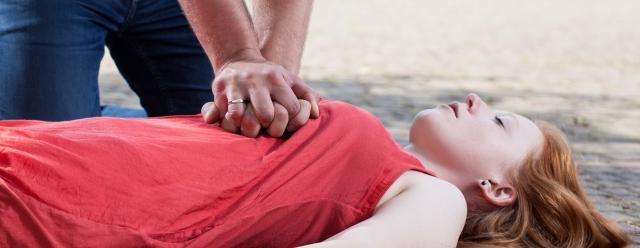Inappropriate Touching, Injury Worries Cited in CPR Gender Disparities
Why it matters
- Performing cardiopulmonary resuscitation (CPR) when someone suffers a cardiac arrest can save their life.
- CPR should be treated as a medical procedure without worries that it will injure a woman or be seen as inappropriate touching.
- Closing gender gaps in resuscitation and hospital care post-cardiac arrest could save more lives.
When someone suffers a cardiac arrest in public, a stranger performing CPR can save a life. Unfortunately, the overall rates of bystander CPR are too low, and women are less often resuscitated than men.1
Sudden cardiac arrest is the abrupt loss of heart function, along with loss of breathing and consciousness, and can lead to death. Cardiopulmonary resuscitation, known as CPR, improves the chance of survival.2
The reasons people believe women receive less bystander CPR vary, a recent University of Colorado study found. They include the perception that a woman in cardiac arrest may be suffering from some other malady or episode, such as fainting; the misconception that women don’t suffer cardiac arrests like men; fear that a woman’s body is frail and that CPR may cause bodily harm; or worry about being accused of inappropriate touching or sexual assault. The researchers used a crowdsourcing platform and analyzed answers from 520 men and women nationwide.3
“The view that CPR administered on a woman will be seen as inappropriate is particularly profound and rooted in an ‘over-sexualization of women’s bodies,’” said Sarah Perman, M.D., an associate professor of emergency medicine at the University of Colorado Anschutz Medical Campus and the study’s senior investigator.
“Bystanders’ hesitancy to administer CPR on women often differed based on the gender of the potential rescuer,” Perman explained. A female rescuer would more likely be deterred because of fear of causing bodily injury or harm, while a male rescuer would more likely be hindered by fear of accusations of sexual assault or harassment or inappropriate touching.
Stepping in to assist
“Potential rescuers should not be thwarted by worries of legal action over touching a person who is clearly in need of help,” Perman pointed out. “Bystander CPR saves lives,” she said. “This is a medical procedure, a life-saving procedure.”
She and other medical experts also note that any physical harm caused by the chest compressions of CPR are negligible when saving someone from death. After all, a fractured rib can heal.
“It’s really important to hit some of these things head on. We need to be very overt in talking about it,” Perman said.
There are more than 350,000 out-of-hospital cardiac arrests each year in the United States. Most happen at home, but about 19% among adults occur in public. CPR performed by a bystander, if it’s started right away, can double or triple the chances of survival. However, one study found that 45% of men received bystander CPR compared with 39% of women, and men had a 23% higher likelihood of surviving than women.4 Immediate use of an automated external defibrillator, or AED, if one is available can also help save a life.5
Gender differences in survival
Beyond bystander hesitancy to perform CPR, other gender differences exist with out-of-hospital cardiac arrests. Researchers are continuing to examine these disparities.
Studies have found that women were less likely to have a cardiac arrest that is witnessed by another person. Of patients who were successfully resuscitated after an out-of-hospital cardiac arrest, women less frequently survived until hospital discharge. Women also had less likelihood of survival with good neurological function in comparison with men, according to a 2020 study published in the journal Circulation.6
Women were also less likely to receive in-hospital procedures known to improve survival after cardiac arrest. The study concluded that future research is needed to better understand and correct these gender differences and outcomes.6
Encouraging CPR, boosting longevity
Medical experts are striving to improve bystander CPR rates for everyone. The American Heart Association issued updated recommendations for CPR training in the Resuscitation Education Science Guidelines published in October 2020 to remove “gender-related barriers.” Instructions for CPR are the same regardless of gender. You should call 911 and press hard and fast in the center of the chest for 100 to 120 compressions per minute, at least two inches deep, until emergency medical service workers arrive.1
The AHA recommends hands-only CPR if someone is not trained in CPR with rescue breaths or needs a simple way to help. It’s aimed at empowering more people to assist someone in distress. It does not involve the mouth-to-mouth rescue breathing of traditional CPR.
“In CPR training, using female-looking mannequins with breasts in training courses can be useful in removing gender barriers,” Perman added. More inclusiveness in other training materials, such as using pictures of women receiving CPR, is another suggested step.
“Dispatcher-assisted CPR, in which the rescuer is guided by a 911 operator, also may help a bystander feel comfortable that they are acting appropriately and could help close gender disparities,” she noted.
Monitoring your health to prevent heart disease
It’s important to remember that women, like men, experience heart disease, the leading cause of death in the United States.7 Certain heart conditions, as well as other medical issues, can lead to cardiac arrest.2
Keeping an eye on numbers such as blood pressure, cholesterol, weight and blood-sugar levels should be a part of women’s health regimens. These are included in the AHA’s Life’s Simple 7, seven risk factors and behaviors everyone can address through lifestyle changes to help improve cardiovascular health.
Along with your physical health, paying attention to financial planning for health can help as you age. Make sure you’re prepared in the event of the unexpected by saving for surprise health-related expenses, arranging for adequate insurance coverage, and planning how to handle or pay for caregiving, if needed.
And, at any time, if you see someone who has collapsed, is unconscious and not breathing, pitch in and help with CPR, regardless of their gender. Don’t be afraid to use your hands to save a life.
“CPR is medical intervention,” Perman emphasized. “You’re giving them their best chance.”
Things to consider
- If you see a teen or adult suddenly collapse, step in immediately to administer hands-only CPR.
- Don’t hesitate to perform CPR because of worries about harming someone or accusations of inappropriate touching; CPR is a life-saving medical procedure.
- Women can experience heart disease and suffer cardiac arrest just like men.
1 “Experts Urge Changes To Improve Rates Of Bystander CPR For Women,” American Heart Association, Go Red for Women, November 2020
2 “Sudden Cardiac Arrest,” Mayo Clinic, November 2021
3 “Abstract 139: Understanding Why Differences In The Provision Of Bystander CPR Exist For Women Versus Men: Does The Sex Of The Rescuer Matter?” Circulation, November 2020
4 “Why People Fear Performing CPR On Women – And What To Do About It,” American Heart Association, November 2020
5 “What Is CPR?” American Heart Association, accessed January 2022
6 “Gender-Based Differences In Outcomes Among Resuscitated Patients With Out-of-Hospital Cardiac Arrest,” Circulation, Dec. 15, 2020.
7 “Heart Disease Facts,” Centers for Disease Control and Prevention, September 2021
This article was prepared by the American Heart Association (AHA). Transamerica is not affiliated with the AHA and does not control, guarantee, or endorse the information. This information does not constitute the practice of medical advice, diagnosis, or treatment. Always talk to your healthcare provider for diagnosis and treatment, including your specific medical needs. If you have or suspect that you have a medical problem or condition, please contact a qualified healthcare professional immediately. If you are in the United States and experiencing a medical emergency, call 911, or call for emergency medical help immediately.
Transamerica Resources, Inc. is an Aegon company and is affiliated with various companies which include, but are not limited to, insurance companies and broker dealers. Transamerica Resources, Inc. does not offer insurance products or securities. The information provided is for educational purposes only and should not be construed as insurance, securities, ERISA, tax, investment, legal, medical or financial advice or guidance. Please consult your personal independent professionals for answers to your specific questions.



